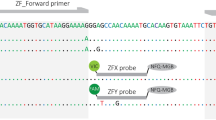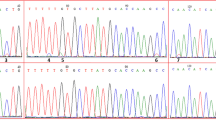Abstract
A non-invasive, fast, and reliable method for sex identification of the giant panda (Ailuropoda melanoleuca) was developed by genotyping five SNPs located at the sex chromosome amelogenin (AMEL) paralogs. The giant panda’s sex can be accurately distinguished by the homozygous or heterozygous SNP genotypes. Mass spectrometry assay and Sanger sequencing both successfully genotyped tissue and fresh fecal samples collected from known-sex giant pandas. Additionally, we simulated the conditions of wild fecal samples, which were naturally degraded for up to two weeks, and successfully genotyped these samples by mass spectrometry assay in parallel. These results suggest that this is a powerful method for sex determination in highly degraded and lower concentrated DNA samples.


Similar content being viewed by others
Data Availability
The AMELX gene sequence, annotation, and Y-linked SNPs were deposited on NCBI nucleotide database with accession ON987233 and synchronously committed to our Github repository (https://github.com/xuweixw/annotation).
References
Buchalski MR, Sacks BN, Ahrens KD, Gustafson KD, Rudd JL, Ernest HB, Dellinger JA (2022) Development of a 95 SNP panel to individually genotype mountain lions (Puma concolor) for microfluidic and other genotyping platforms. Conserv Genet Resour 14:147–150. https://doi.org/10.1007/s12686-022-01255-6
Castellanos-Rubio A, Ghosh S (2019) Disease-associated SNPs in inflammation-related lncRNAs. Front Immunol 10:420. https://doi.org/10.3389/fimmu.2019.00420
Degtyareva AO, Antontseva EV, Merkulova TI (2021) Regulatory SNPs: altered transcription factor binding sites implicated in complex traits and diseases. Int J Mol Sci 22:6454. https://doi.org/10.3390/ijms22126454
Durnin ME, Palsbøll PJ, Ryder OA, McCullough DR (2007) A reliable genetic technique for sex determination of giant panda (Ailuropoda melanoleuca) from non-invasively collected hair samples. Conserv Genet 8:715–720. https://doi.org/10.1007/s10592-006-9196-8
Dwiningsih Y, Rahmaningsih M, Alkahtani J (2020) Development of single nucleotide polymorphism (SNP) markers in tropical crops. Adv Sustain Sci Eng Technol 2(2). https://doi.org/10.26877/asset.v2i2.6279
Li Y, Xu W, Wang Y, Kou J, Zhang J, Hu S, Zhang L, Wang J, Liu J, Liu H, Luo L, Wang C, Lan J, Hou R, Shen F (2022) An improved, chromosome-level genome of the giant panda (Ailuropoda melanoleuca). Genomics 114:110501. https://doi.org/10.1016/j.ygeno.2022.110501
Sanchez-Mazas A (2020) A review of HLA allele and SNP associations with highly prevalent infectious diseases in human populations. Swiss Med Weekly 150:w20214. https://doi.org/10.4414/smw.2020.20214
Swaisgood R, Wang D, Wei F (2016) Ailuropoda melanoleuca (errata version published in 2017). The IUCN red list of threatened species 2016: e.T712A121745669. https://doi.org/10.2305/IUCN.UK.2016-2.RLTS.T712A45033386.en
Xu X, Wei K, Zhang W-P, Lin L, Wang X-F, Shen F-J, Zhang L, Zhang Z-H, Yue B-S (2007) A novel method for sex determination of giant panda. Ann Zool Fenn 44(6):401–404
Xu X, Lin L, Zhang Z, Shen F, Zhang L, Yue B (2008) A reliable, non-invasive PCR method for giant panda (Ailuropoda melanoleuca) sex identification. Conserv Genet 9:739–741. https://doi.org/10.1007/s10592-007-9376-1
Zou X, He G, Liu J, Jiang L, Wang M, Chen P, Hou Y, Wang Z (2022) Screening and selection of 21 novel microhaplotype markers for ancestry inference in ten Chinese subpopulations. Forensic Sci Int: Genet 58:102687. https://doi.org/10.1016/j.fsigen.2022.102687
Funding
This study is supported by the grants from the Sichuan Natural Science Foundation Project (2022NSFSC0009) and an independent project of the Chengdu Research Base of Giant Panda Breeding (No. 2020CPB-B01). We sincerely thank James Ayala for polishing the English grammar of the manuscript.
Author information
Authors and Affiliations
Contributions
FS and WX designed this study. WX analyzed the data and wrote this manuscript. WX, DX, JK, XZ, and other colleagues collected those samples and performed experiments.
Corresponding author
Ethics declarations
Conflict of interest
Not applicable.
Additional information
Publisher’s Note
Springer Nature remains neutral with regard to jurisdictional claims in published maps and institutional affiliations.
Rights and permissions
Springer Nature or its licensor (e.g. a society or other partner) holds exclusive rights to this article under a publishing agreement with the author(s) or other rightsholder(s); author self-archiving of the accepted manuscript version of this article is solely governed by the terms of such publishing agreement and applicable law.
About this article
Cite this article
Xu, W., Xie, D., Kou, J. et al. Development of SNP markers to identify the sex of the giant panda from naturally degraded fecal samples. Conservation Genet Resour 16, 23–26 (2024). https://doi.org/10.1007/s12686-023-01326-2
Received:
Accepted:
Published:
Issue Date:
DOI: https://doi.org/10.1007/s12686-023-01326-2




